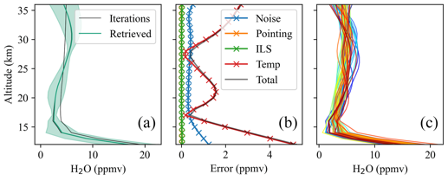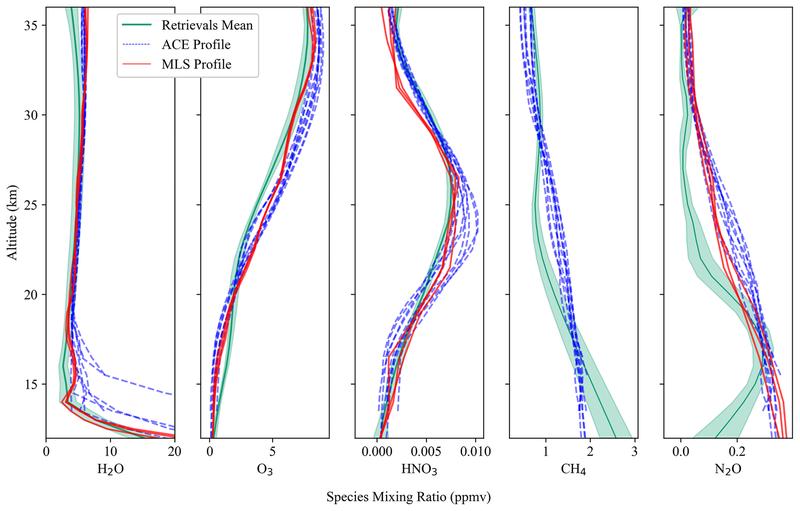This study presents the approach to retrievals of trace gas profiles, and the characterization of these resulting profiles, for the prototype Limb Imaging Fourier Transform Spectrometer Experiment (LIFE) instrument. LIFE is an imaging Fourier transform spectrometer (IFTS), measuring between 700 and 1400 cm−1, designed to make composition measurements in the upper troposphere - lower stratosphere (UTLS) with high spatial resolution using a limb-viewing geometry. For the test flight, the LIFE instrument was flown on a a stabilized stratospheric balloon gondola from Timmins, Canada in 2019.
The retrievals from LIFE employ the optimal estimation method and use the SASKTRAN radiative transfer model as their forward model. Currently, vertical profiles of five trace gas species (H2O, O3, N2O, CH4, and HNO3) are retrieved from the test flight spectra. Retrievals are performed over a set of six broad microwindows, loosely based on those employed for the Michelson Interferometer for Passive Atmospheric Sounding (MIPAS) instrument, and chosen for their sensitivity to these five species over the UTLS. Each species is retrieved in the order listed and used as input for the next retrieval in the list. The exception to this is CH4 and HNO3, which are retrieved simultaneously. Temperature information for the retrieval comes from the Modern-Era Retrospective analysis for Research and Applications (MERRA). As the retrieval is performed on a finer grid than the LIFE measurement grid, a second-order Tikhonov regularization is applied to the averaging kernel to smooth the profile, with a species-dependent regularization factor. The results of these retrievals are shown for water vapour in Figure 1.

Figure 1: Retrieval results for water vapour. The leftmost panel (a) shows the iterations and final retrieved profile for a single measurement made during the balloon test flight on 1 September 2019, with the shaded region showing the total error from all sources. The middle panel (b) shows the associated errors incorporated in the retrieval, and the rightmost panel (c) shows all successfully retrieved profiles for the period between 06:21:05 and 08:00:59 UTC on 1 September 2019.
In order to assess the accuracy of the LIFE retrievals, they have been compared to measurements from the ACE-FTS and Aura Microwave Limb Sounder (Aura-MLS). The ACE-FTS measurements used were made between 6 and 9 September 2019 between 43 and 52 degrees latitude, while those from Aura-MLS were made on 1 September 2019 between 47 and 51 degrees latitude. LIFE made measurements at approximately 48 degrees latitude on 1 September 2019. The results for these comparisons are shown in Figure 2. Overall, H2O and O3 are found to be low-biased on average, and a smaller, but still significant, low bias is also observed with HNO3. Despite these biases, these three species show agreement in the general shape and magnitude of the retrieved profiles with those of the comparison instruments. In contrast, both N2O and CH4 show significant disagreement with ACE-FTS and Aura-MLS, indicative of a unknown problem in the retrieval requiring further radiometric correction. However, the general agreement noted with the first three species illustrates the feasibility of the LIFE instrument concept and retrieval scheme.

Figure 2: Comparison of the mean of the trace gas profiles retrieved from LIFE with coincident profiles from ACE-FTS (blue) and Aura-MLS (red). The shaded area around the mean LIFE profile indicates the standard deviation of the LIFE retrievals.
